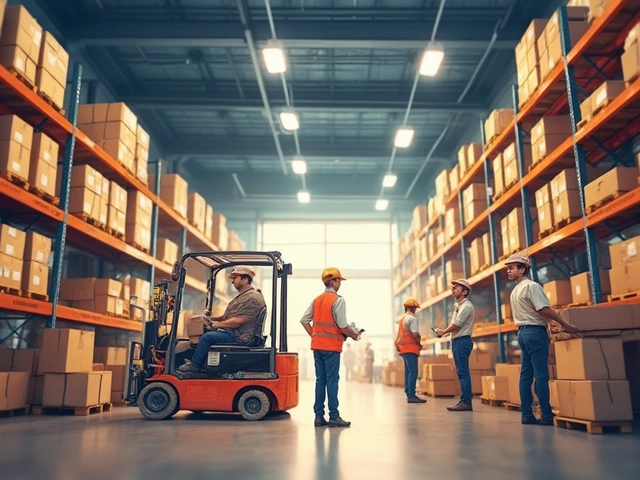Ever wondered which part of logistics brings in the big bucks? The logistics industry isn't just a single cog in the machine; it's a whole mechanism of high-earning parts that keep the entire system rolling profitably. Let's kick things off with the concept of profit centers. In logistics, these are specific operations or segments that can generate significant revenue for companies.
Take supply chain management. It's a massive part of logistics that ensures goods move seamlessly from point A to point B. Companies that master supply chain logistics cut costs and improve speed, making it a cash cow for those who get it right.
- Understanding Profit Centers
- Supply Chain Management
- Warehouse and Storage
- Last-Mile Delivery
- Tech-Driven Opportunities
Understanding Profit Centers
In the world of logistics, identifying profit centers is a game-changer. These are parts of a business that directly generate income, making them focal points for strategic planning and investment. Recognizing and optimizing these areas can significantly boost a company's bottom line.
Supply Chain Management as a Cash Cow
Many logistics companies have discovered gold mines in supply chain management. Efficiently moving products from suppliers to buyers not only reduces costs but also drives profitability. Companies that excel at this leverage technology to track shipments, manage inventory, and even predict future trends, ensuring they always stay a step ahead.Warehouse and Storage
Though it might sound old-school, good old-fashioned storage facilities are still cash generators. In the era of e-commerce, the demand for warehousing space is booming. Strategic location, efficient operations, and technologies like AI-driven inventory management enhance profitability.The Rise of Last-Mile Delivery
As online shopping grows, last-mile delivery has become a hot profit center. It's the final step in logistics and plays a crucial role in customer satisfaction. Businesses investing in this area witness increased revenues as speedy, reliable delivery becomes a competitive edge.Exploring Tech-Driven Opportunities
Lastly, technological advancements offer new revenue streams. Automation, data analytics, and blockchain are transforming logistics. Companies using these to optimize operations find themselves with higher profit margins.To illustrate how these profit centers are performing, here's a snapshot of the impact of efficient logistics operations:
| Area | Average Profit Increase (%) |
|---|---|
| Supply Chain Management | 15% |
| Warehouse & Storage | 10% |
| Last-Mile Delivery | 20% |
Spotting these areas and capitalizing on them isn't just smart—it's necessary for anyone looking to make a mark in the logistics industry.
Supply Chain Management
When you think about supply chain management, imagine it as the orchestrator of the logistics industry. Its main aim? To make sure everything moves like clockwork from suppliers to consumers. It's a crucial part of why some logistics companies rake in more cash than others.
One might ask, what's the secret sauce here? It's all about streamlining processes, reducing costs, and ensuring top-notch service. A well-oiled supply chain doesn't just cut delays, it slashes unnecessary costs. And in this game, every penny saved is a penny earned.
The backbone of effective supply chain management often lies in technology. Advanced data analytics and AI help predict demand, manage inventory, and even optimize delivery routes. Companies that effectively use these tech tools often see a significant boost in profitability.
Predictive Analytics
Predictive analytics is like having a crystal ball. It takes historical data, mixes it with some AI magic, and bam! You've got insights on what, when, and where your products will be needed. Logistics companies that tap into this can minimize waste and maximize profits.
Cost Reduction Strategies
Cost is king in logistics. Think bulk purchasing, effective route planning, and smart inventory management. Each of these strategies has been time-tested to save money, which companies can then invest back into improving their operations.
| Year | Cost Savings (%) |
|---|---|
| 2022 | 12 |
| 2023 | 15 |
As seen above, the right strategies can significantly reduce operational costs over time.
Simplifying the complex web of supply chain makes it possible for companies to thrive even in competitive markets. This is why players in supply chain management often enjoy the lion’s share of the profits in the logistics industry.

Warehouse and Storage
When it comes to raking in profits, warehouse and storage operations are the unsung heroes of the logistics industry. Imagine a vast space packed with potential earnings. Warehouses are not just about stacking goods; they're about efficiency and strategic placement. And if you think it's just big companies that see value here, think again.
Strategic Location Matters
The location of a warehouse can make or break its cost-efficiency. Proximity to major highways and urban centers can lower transport costs significantly. Companies often place warehouses strategically to optimize delivery routes and reduce shipping times. This isn't just about convenience; it's a calculated move to boost profits.
Value-Added Services
Warehouses aren't just spaces filled with shelves. Many offer value-added services like repackaging, labeling, and even light assembly. These services aren't just extra perks but are lucrative solutions businesses can charge for, enhancing their revenue streams.
Tech-Driven Efficiency
Technology plays a crucial role in modern warehousing. AI and robotics streamline inventory management, reducing errors and speeding up processes. These tech enhancements not only save money but also boost customer satisfaction with faster, accurate deliveries. It's a win-win.
Cold Storage: Hot Opportunity
With the growing demand for fresh produce and pharmaceuticals, cold storage has become a lucrative niche. Facilities equipped with refrigeration systems command higher prices due to their specialized nature. This segment has seen a boom, driven by the rise in e-commerce and grocery deliveries.
| Type of Storage | Profit Margin |
|---|---|
| Traditional Warehouse | 10-15% |
| Cold Storage | 15-20% |
All in all, warehousing isn't just about storing products. It's a complex, valuable part of the logistics puzzle that, when run efficiently, delivers significant profits.
Last-Mile Delivery
Ah, the last-mile delivery—where logistics meets your doorstep. This final stretch is where goods go from local distribution centers to the customer's hands, and it's shaking things up in the logistics world.
Here's the kicker: last-mile delivery accounts for over 50% of total shipping costs. That's a hefty chunk, especially with online shopping hitting record highs. Everyone from global giants to local startups is racing to crack the code on cost efficiency while keeping customers happy.
Challenges and Innovations
Urban areas are congested, and delivery windows are narrowing as people demand faster and more reliable service. Enter innovations like drones and autonomous delivery vehicles, which are inching closer to becoming mainstream, thanks to tech advancements.
Logistics companies are also playing with crowdsourced delivery models. Think of it like Uber but for packages—tapping into local drivers to help bridge the gap. It’s a win-win, as it creates jobs while cutting down costs for logistics companies.
Table: Key Figures in Last-Mile Delivery
| Year | E-commerce Share (%) | Delivery Cost Increase (%) |
|---|---|---|
| 2020 | 20 | 15 |
| 2023 | 30 | 25 |
| 2025 | 35 (projected) | 30 (projected) |
As e-commerce continues to boom, the push for eco-friendly delivery solutions is also on the rise. Electric bikes, compact delivery vans, and other green vehicles are popping up everywhere in a bid to cut emissions. It's not just about being green—it's about having the competitive edge as customers lean more towards companies that value sustainability.
The last-mile delivery sector is rapidly evolving and offers plenty of opportunities. As the landscape changes, staying ahead means keeping an eye on new technologies and being adaptable to the shifting expectations and demands of consumers.

Tech-Driven Opportunities
It's no secret that technology is shaking up every industry out there, and logistics is no exception. The rise of tech-driven opportunities is transforming how logistics companies operate, boosting efficiency, and ultimately, profitability.
One area seeing massive benefits is automation. Think about warehouses using robotics to handle picking and packing. This isn't just a sci-fi concept anymore—automated systems significantly cut down human error and speed up operations. Companies like Amazon have fleets of robots whizzing around, doing jobs humans used to do.
Artificial Intelligence and Data Analytics
AI and data analytics are another goldmine. These tools analyze massive datasets to forecast demand more accurately and optimize delivery routes. By doing so, companies reduce fuel costs and deliver better customer service—key factors in staying competitive in the logistic field.
Additionally, AI-powered systems help in dynamic pricing and predictive maintenance of logistics equipment. These tools help predict when machinery might fail, minimizing downtime, and saving money.
The Internet of Things (IoT)
Now, let's talk IoT. With sensors attached to goods and vehicles, companies gain real-time visibility of their assets. This real-time tracking streamlines inventory management and reduces losses from theft or spoilage.
For example, refrigerated trucks carrying perishable goods can be monitored constantly to ensure they maintain the correct temperature. Businesses can act quickly if they notice deviations, preventing loss of products.
Blockchain for Transparency
And don't forget about blockchain. Often associated with cryptocurrencies, blockchain in logistics focuses on supply chain transparency and security. Secure and transparent records of transactions create trust between partners in the supply chain, reducing disputes and payment delays.
An added bonus? Blockchain tech can help verify the authenticity and origin of goods, adding another layer of security.
As logistics firms continue to embrace technology, the doors to potential profitability swing wide open. The key lies in smart integrations and staying ahead of tech trends tailored specifically for the logistics world.





